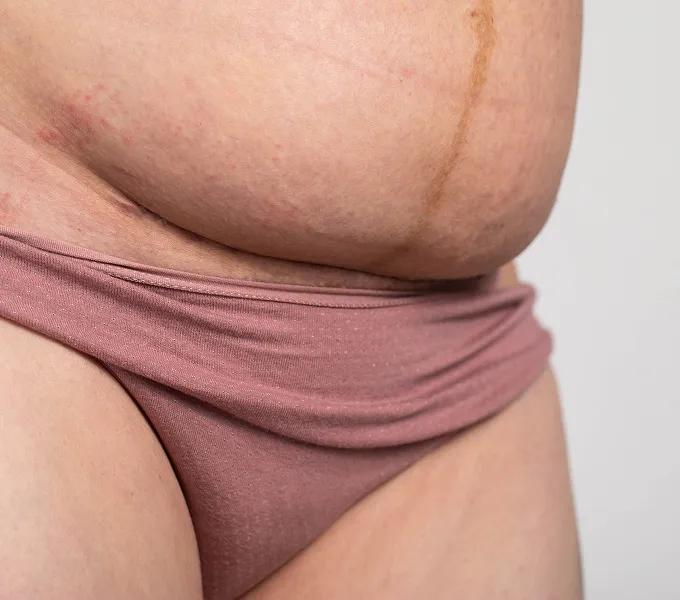
9 Moves for Instant Relief of Postpartum Neck Pain
Being newly postpartum, your life has changed a lot. You no longer sleep more than 2 hours at a time, you don't have a pregnant belly to lug around anymore, and you spend a lot more time looking down. Whether you're lifting or lowering your baby from place to place, monitoring your newborn in tummy time, picking up toys and books scattered across the floor, or helping your little one get a good latch and keep it, the amount of time you spend looking up and out at the world has inevitably disappeared overnight.
Unfortunately, all that looking down comes at a cost. Postpartum neck pain — aka "nursing neck" is incredibly common and can make you extremely uncomfortable. The moves below can bring you some relief, but if pain continues, see a physical therapist to get it taken care of. Caring for your baby should never hurt.
Why gazing down at baby is bad for your neck
Research shows that, for every degree forward that you tilt your head, you increase the amount of work your neck muscles need to do in order to hold that pose. The average head weighs 10-12 pounds, but when you bend your neck even 30 degrees, the relative weight of your head comes closer to 40 pounds!
That's a lot of work and the sudden increased demand on your body can make even the healthiest person a victim of postpartum neck pain.
Moves that relieve postpartum neck pain
1. First, create a few new habits
With a baby to care for, there are so many times when you can't avoid looking down, so it's important that you modify those times when you can.
- If you use a laptop often, consider buying a Bluetooth keyboard and a laptop stand that brings your screen to eye level. In lieu of a stand, you can also use a box and/or a stack of books.
- When quickly checking your phone, hold it up in front of your eyes and adjust your neck to bring your ears in line with your shoulders.
- For longer scroll sessions at home, hold your phone at eye level, using pillows or an armrest to support your arm in this position.
- When nursing or bottle-feeding, take frequent breaks from downward gazing (look up and bring ears in line with your shoulders).
2. Massage out tension using a tennis or lacrosse ball
- Stand up straight with your back to a wall.
- Place a ball against the wall and lean your upper back onto the ball. The ball should be between your spine and your shoulder blade on the side you would like to work.
- Roll the ball around the area. If you feel a particularly tender spot, hold the position leaning back onto the ball to apply more pressure on the area until it releases. Tip: Never roll the ball over the base of your neck or onto your spine.
Note: This should not be painful but may be uncomfortable. If pain, numbness or tingling occur while doing this exercise, stop and reach out to your primary care provider or physical therapist for guidance.
3. Open up with wall angels
- Stand with your back and heels up against a wall.
- Bring your arms out to your sides, flattening them against the wall at a 45 degree angle.
- Keep your forearms on the wall as you slide your arms along the wall up towards your head, and back to the starting position. Tip: Keep your shoulders relaxed and away from your ears for the duration of the movement.
Note: You may experience tingling in your fingertips with this exercise, this sensation should resolve with stopping the exercise, if it remains, discontinue this exercise and reach out to your primary care provider.
4. Bring your ears back with chin tucks
- Lay on your back with shoulders away from your ears.
- Lengthen the back of your neck by tucking your chin down towards your chest, and drawing the back of your head upwards slightly. Tip: Imagine a string being pulled out of the top of your head as you tuck. Keep your head on the ground.
- Hold for a few seconds, then repeat.
Note: If this exercise makes you lightheaded, stop and consult your primary care provider.
5. Stretch tight, overworked neck muscles
- Sit upright on a chair with your feet flat and arms at your sides.
- Slowly bring your ear to your shoulder as you tilt your head to the side. You may gently rest your hand on your head for added weight and stretch. Tip: Keep your shoulders down and away from your ears for the duration of the stretch.
- Hold the stretch and breathe, then slowly return to the start position.
Note: Stop if this causes pain, also do not make sudden movements when releasing this stretch, be slow and gentle to return to neutral
6. Strengthen those back muscles
- Start standing upright with your arms at your sides and your palms facing out.
- Bend your elbows and bring your forearms up to your sides.
- Keep your shoulders away from your ears as you squeeze your shoulder blades together, bringing your elbows back behind you like you are attempting to touch them together.
- Return back to the start position.
Note: This should not be painful. If this causes pain, reduce how far you bring your shoulders back or how much force you generate and try again.
7. Give your pecs some love, too
- Standing facing a doorway or corner of a wall. With your elbow bent at a 90-degree angle, place your forearm and palm on the edge of the wall, keeping your elbow in line with your shoulder. Tip: Keep your shoulder down and away from your ear for the duration of the stretch.
- Lunge forward with the foot closest to the wall, then rotate your head and upper body away from the wall, feeling a stretch across one side of your chest.
- Hold the stretch and breathe.
Note: You may experience tingling in your fingertips with this exercise, this sensation should resolve with stopping the exercise, if it remains, discontinue this exercise and reach out to your primary care provider.
8. Lean back
- Place a large foam roller horizontal on the floor.
- Lie back onto the foam roller with the roller positioned just below your shoulder blades. Wrap your hands around the back of your head for support.
- Inhale to begin, then as you exhale as you relax your upper body over the foam roller.
- Hold this position and breathe.
Note: Individuals with spinal stabilization surgeries may not be appropriate for this stretch, consult your surgeon prior to attempting. This should not be painful, only lean as far back as feels comfortable while still being able to return to neutral after the stretch.
9. Move your spine from top to bottom
Start lying on your side with both legs bent at a 45-degree angle to the hips, knees together. Extend both arms straight out at shoulder level, palms together. Tip: Put a pillow between your knees for added comfort.
- Inhale and raise your top arm straight up toward the ceiling. Keep your eyes focused on your palm, rotating your head and upper body to keep your shoulder in line with your arm.
- Exhale and continue to rotate the spine, opening like a "book" as you lower your arm down towards the floor behind you (or stop at the point that feels comfortable for you).
- Inhale and reach your arm back toward the ceiling again, then exhale as you rotate your arm, upper body, and head back to starting position.
Note: Individuals with spinal stabilization surgeries may not be appropriate for this stretch, consult your surgeon prior to attempting.




